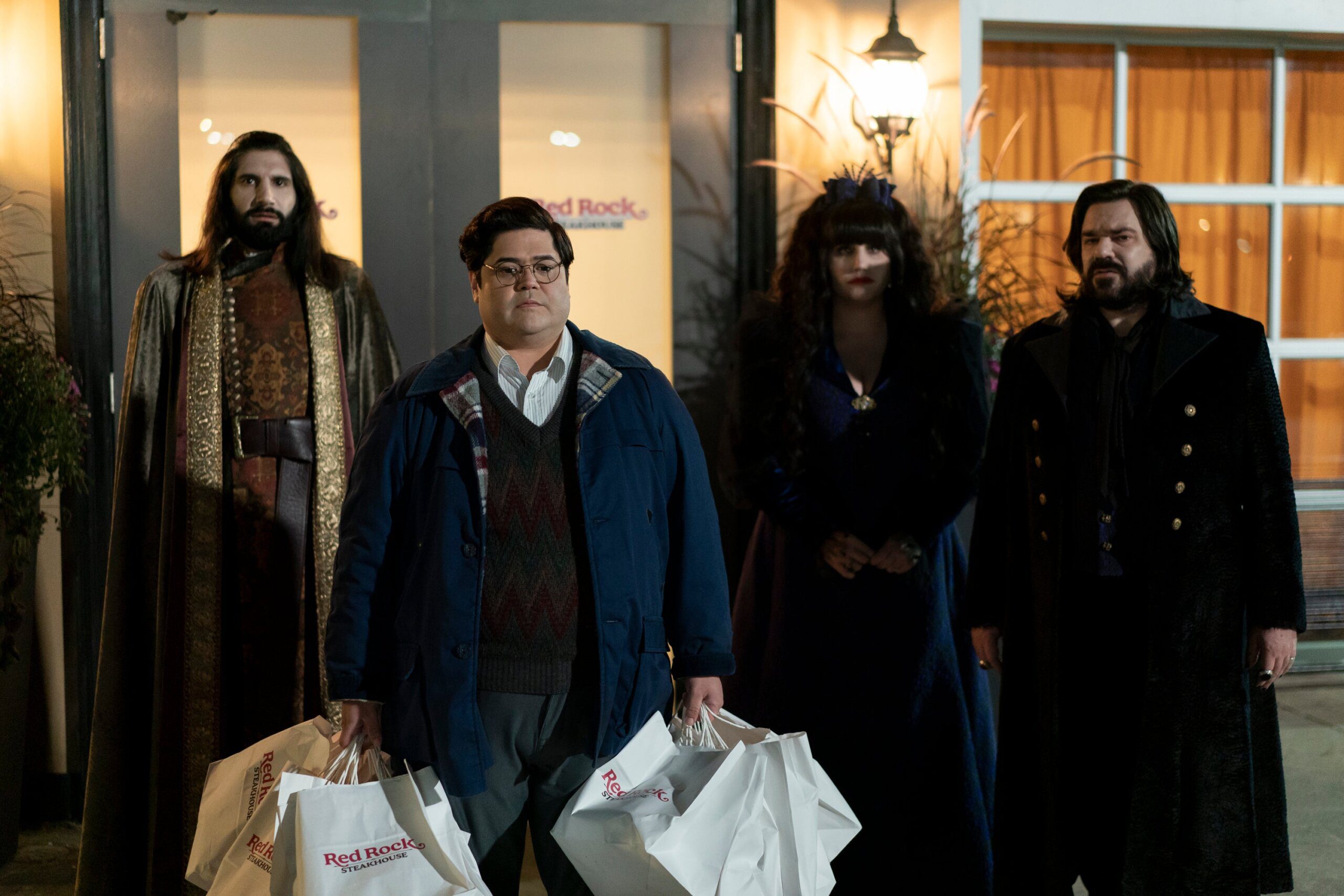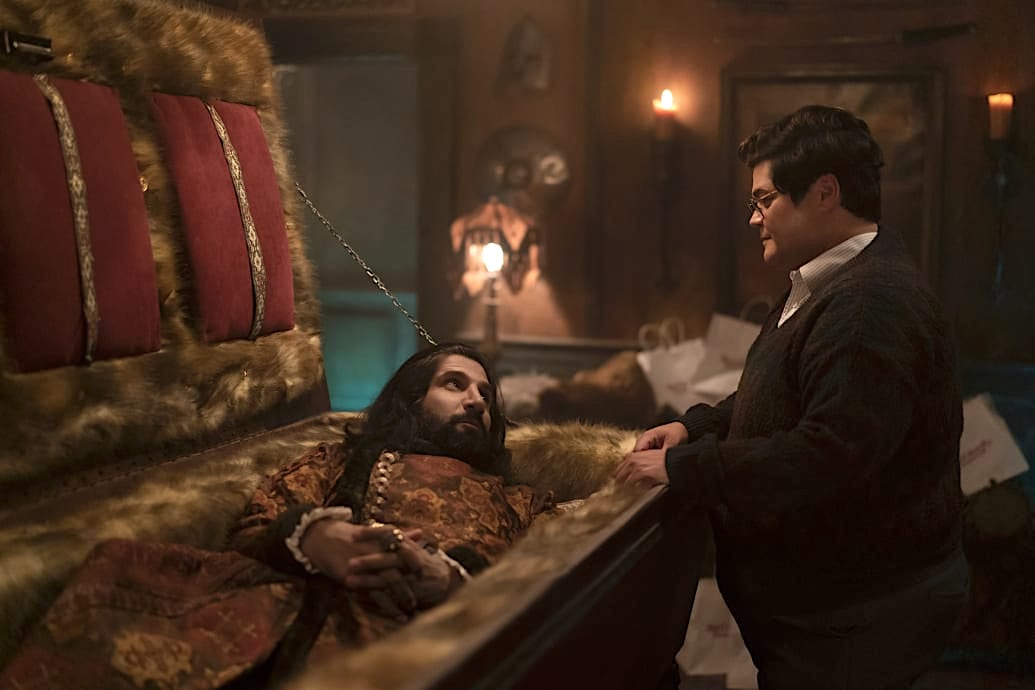What We Do in the Shadows is one of the funniest and most unapologetically queer shows on TV—and it only keeps getting gayer. The mockumentary-style series, based on a film of the same name directed by Jemaine Clement and Taika Waititi, follows a group of four sexually fluid vampires and their gay human familiar all living under one roof in Staten Island. Why Staten Island? Because that’s where the boat dropped them off.
Now in its fifth season, What We Do in the Shadows offers a satirical spin on classic vampire tropes, highlighting the absurdity of ancient supernatural beings doing mundane human things like going to the gym or attending Super Bowl parties (which they think is a celebration for a superb owl).
As amusing as it is to watch vampires struggle to blend in with their human neighbours and fail in their hope to take over Staten Island, much of the show’s heart and humour come from the characters’ queer storylines, which get more explicitly queer with every passing season. Whether it’s married vampires Laszlo (Matt Berry) and Nadja (Natasia Demetriou) going from snacking on passersby in the park to discussing their sexual exploits with people of all genders or Nandor (Kayvan Novak) forcing his human familiar Guillermo (Harvey Guillén) to hunt for virgins one minute or making him a glitter portrait the next, the series depicts the characters’ queerness as a given.
Save for Guillermo, none of the vampires come out or really even discuss their sexual orientation. It’s as if the show’s creators got together and said, “Of course they’re queer. They’re vampires.”
Warning: the following contains numerous spoilers of the series’ gayest moments.

“What We Do in the Shadows” Season 5 premiere starring Kayvan Novak as Nandor, Harvey Guillén as Guillermo, Natasia Demetriou as Nadja and Matt Berry as Laszlo. Credit: Russ Martin/FX
It’s established very early on that the witty and charming Laszlo is not straight; the theatrical British vampire casually admits in the pilot that he had an affair with vampire royalty Baron Afanas (Doug Jones). Throughout the series, he also repeatedly talks about his past flings and current objects of affection, many of whom are men. While Laszlo is by far the most vocal and outspoken about his queerness, the other vampiric members of this codependent chosen family are just as nonchalant about their sexuality.
Nadja, who is constantly reminiscing about her human life in Antipaxos, first admits in Season 1 that she has been with other women, telling the documentary camera crew in passing that her reincarnated human lover Gregor once came back to life as a washerwoman. In the same season, the insufferable Colin Robinson (Mark Proksch), who feeds on people’s energy instead of their blood, awkwardly tries to get Nadja and Laszlo to have a threesome with him after throwing an elaborate yet unsuccessful orgy and is immediately rejected.
Aside from his complicated relationship with Guillermo, however, the queerness of Nandor—a former Ottoman warrior who now spends his days calling house meetings and explaining vampire etiquette—remains unmentioned until Season 2, Episode 9, when he and Laszlo agree to “finish each other off and tell no one” after being kidnapped by witches and drugged with “witch Viagra.” It’s also made clear that this is apparently not the first time the two have hooked up.
Seasons 4 and 5, however, are considerably more gay than the first three, delving deeper into the queerness of all of its main characters, including the often ignored Guillermo, who is constantly reminded by his vampire friends that he is not one of them.
In Season 4, Episode 5, Nandor and Laszlo pretend to be a couple to help get Colin, now reborn as a baby, into an exclusive private school. Convinced that a less traditional family structure will improve Colin’s chances of getting accepted, Laszlo says, “Trust me. Gay is in. Gay is hot. I want some gay. Gay it’s gonna be.” The two then go into laughably uncomfortable detail about their pretend sex life as “completely gay” husbands before wiping the interviewer’s mind. Then, in Episode 6 of the same season, Nandor asks a djinn to resurrect his 37 wives from his human life, not all of whom are women. “Some of my wives were girl wives, some of them were guy wives; it’s not that different,” Nandor says. After settling on Marwa to become his bride once again, he compels her to like everything he likes, which causes her to take a particular interest in Guillermo, much to his surprise.
Although the signs are there, like his unspoken feelings for Nandor and his desire to become a vampire just like Antonio Banderas’s queer-coded character Armand in Interview with the Vampire, mild-mannered Guillermo doesn’t talk about his sexual orientation or his love life until he accidentally comes out in Season 4, Episode 7.
After Nadja interrupts his family dinner party, Guillermo nervously explains away her presence in the house by claiming that she’s his girlfriend, but since his family has Van Helsing—vampire hunter—blood, they quickly realize she’s a vampire and try to stake her. In order to distract them, Guillermo reveals that he’s gay and that Nadja is his vampire friend. In a heartfelt moment, his family affirms him and admits that they already knew he was gay. “Familia es familia,” his cousin Miguel says. The only issue they seem to have is with his desire to become a vampire.
It is through this scene that the show touches on the long history of vampires, and other monsters, being coded as queer in books and movies. For many decades, this queerness has often been quite subtle, using vampires as allegories for outcasts who harbour “forbidden” desires and are feared because of them. It’s no wonder why so many queer people have been drawn to them. Bram Stoker, who wrote the infamous novel Dracula, is believed to have been a queer man himself, and many fans have interpreted his 19th-century work as an expression of repressed homosexual desires. Nearly two centuries later, however, the inherent queerness of vampires is no longer simply subtext; it is now plainly stated. What was once ambiguous and metaphorical is very much out in the open, and shows like What We Do in the Shadows, First Kill, and AMC’s Interview with the Vampire remake demonstrate just how fun and meaningful that can be.
The gay subtext has all surfaced with Guillermo in the latest season when he finally gets a boyfriend after Freddie (Al Roberts) pays Guillermo a surprise visit at the vampires’ residence. But Nandor soon becomes infatuated with Freddie and turns Marwa into a clone of Freddie, whom he then dates. Eventually, through a series of twisted events involving mind-erasing, the two Freddies end up kissing one another—a sight that truly horrifies Guillermo.
Perhaps the wildest and most hilariously gay episode, however, is Season 5’s Pride episode, in which the vampires are tasked with helping their neighbour Sean Rinaldi throw a Pride Parade, because, as Rinaldi puts it, they’re all “members of the LGBTQ LMNOP community.”
While he is not queer, Rindaldi is running for comptroller and thinks hosting the parade will help him win the LGBTQ2S+ vote. In typical What We Do in the Shadows fashion, however, nothing goes as planned.
Instead of helping, Nandor tries to impress Guillermo by flying to space, only to burn up in the atmosphere and crash-land right in the middle of the celebration. At the same time, Laszlo is preoccupied with trying to help now half-human, half-vampire Guillermo get to the bottom of his unusual predicament by experimenting with Guillermo’s sweat. The self-appointed “King of Bottoms” uses it as a form of sunscreen so he can walk around in the daylight.
Meanwhile, Nadja switches bodies with her doll, Freaky Friday-style, so her virginal ghost can have sex, going on multiple dates with men and women, to no avail. Guillermo, on the other hand, is absent for much of the episode, only showing up near the end of the parade to sit on a Pride float while holding a paper sign that just reads “Gay Guy.”
Even though Guillermo is once again neglected, he is finally close to living his dream of becoming a full-fledged vampire, which is quite possibly one of the gayest things he could do. That is, if he’s ready for it. Vampirism may no longer be an allegory for queerness, but it still parallels some aspects of the queer experience, like the fear of familial rejection, something Guillermo is experiencing this season now that he is changing into a creature of the night.
While his family accepts him for being gay, vampires are still considered monsters, no matter how lazy or silly or horny they may be.
What We Do in the Shadows screens on FX, Prime and Disney+ in Canada (only up to Season 4 for the latter). In the U.S., it streams on Hulu and is shown live on FX (where it’s now up to Season 5, Episode 6).


 Why you can trust Xtra
Why you can trust Xtra


